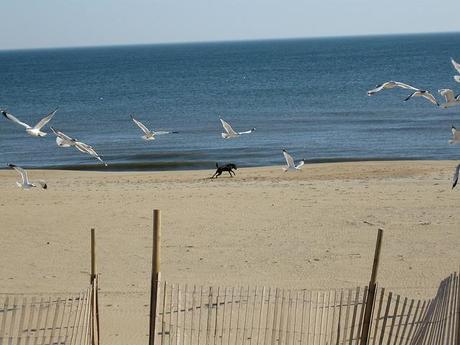 If you spent time at the beach this summer, you probably encountered seagulls screeching overhead and eating trash. You probably also encountered their poop. Seagull droppings can carry disease-causing microbes like Escherichia coli and Enterococcus, which can contaminate beaches and water.
If you spent time at the beach this summer, you probably encountered seagulls screeching overhead and eating trash. You probably also encountered their poop. Seagull droppings can carry disease-causing microbes like Escherichia coli and Enterococcus, which can contaminate beaches and water.
Now scientists have found a way to fight back: Release the hounds. In a new study, researchers show that unleashing dogs keeps the seagulls away — and the water at the beach free of microbes.
Beach managers have been fighting seagulls for decades. The more birds, the more microbes, and the more likely the beach will meet the guidelines for closing, as advised by the Environmental Protection Agency (EPA).
In a recent study, researchers from the U.S. Department of Agriculture tried reducing gull populations on Chicago beaches by “oiling” their nests — spraying oil on the eggs to prevent the birds from hatching. That tactic had some short-term success, but its long-term benefits are unclear.
Chicago beach managers have also used dogs to chase away gulls, which anecdotal evidence suggests has helped reduce the microbe counts and thus the number of beach closures.
To more definitively connect the gulls’ dog-inspired dispersal to microbe concentrations, a team of researchers led by Reagan Reed Converse, an environmental microbiologist at EPA in Chapel Hill, N.C., examined water quality at North Beach in Racine, Wis. During the summer, managers regularly “groom” the beach, located on the shores of western Lake Michigan north of Chicago, by turning over the sand, which buries any microbes left from bird poop.
North Beach’s managers have also worked to remove other sources of pollution, such as sewage runoff, leaving the gulls as the primary source of contaminants in the water.
The team collected beach water samples for the first 11 days of August 2011 to get a baseline bacterial count. Then, they sent in the dogs. One such hired dog posse, made up of one or two trained border collies and their human handler, chased ring-billed and herring gulls away from the sand from sunrise to sunset. (The handlers make sure that dogs leave endangered species, such as piping plovers, alone. They also collect the dogs’ poop.)
After a week of similar beach clearing, the researchers began sampling again — while the dogs kept patrolling — until August 27, for a total of 9 relatively gull-free days.
The dogs had a significant impact. When the team analyzed its samples in the lab, measuring the concentrations of E. coli, Enterococcus and other contaminants, it detected the presence of potentially pathogenic bacteria like Salmonella and Campylobacter (a species that includes C. jejuni, a common cause of gastroenteritis) for seven of the 11 pre-dog sampling days.
But during the nine gull-free days, the team couldn’t detect the bacterial pathogens at all, and the levels of E. coli and Enterococcus species dropped dramatically and rapidly: A reduction of half the gull population decreased E. coli and Enterococcus species by 29 percent and 38 percent, respectively, the researchers report this month in Environmental Science & Technology.
Although technically called “gull harassment,” Converse says the dogs provide a humane and effective deterrent method, albeit one that can be costly, if the dogs were brought in daily throughout the summer (oiling nests, in contrast, is a one-time expense).
Airports and other sites can set up nets or set off shotguns, but those methods wouldn’t be a good idea at a public beach. And while oiling gull eggs brings long-term results, they are not as immediate as simply chasing away the gulls. The “critical next step,” she adds, is to show that those pathogens are actually infective strains that could get humans sick.
Connecting gull poop to actual human illness is difficult, however, cautions Richard Whitman, a research ecologist and station chief of the U.S. Geological Survey’s Lake Michigan Ecological Research Station in Porter, Ind.
Other birds — including Canada geese — and mammals could be sources of poop-borne bacteria, Whitman says, as could algae that incubate E. coli and other critters in the right conditions. Even so, he says the new study shows just how effective controlling seagulls can be on improving water quality.
By Naomi Lubick
ScienceNOW
Tags: beach water, E. coli, Environmental Protection Agency, Microbes, Summer Vacation, unleashed dogs and seagulls
